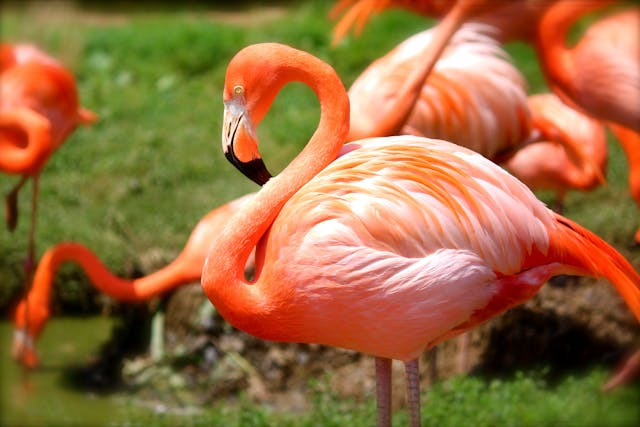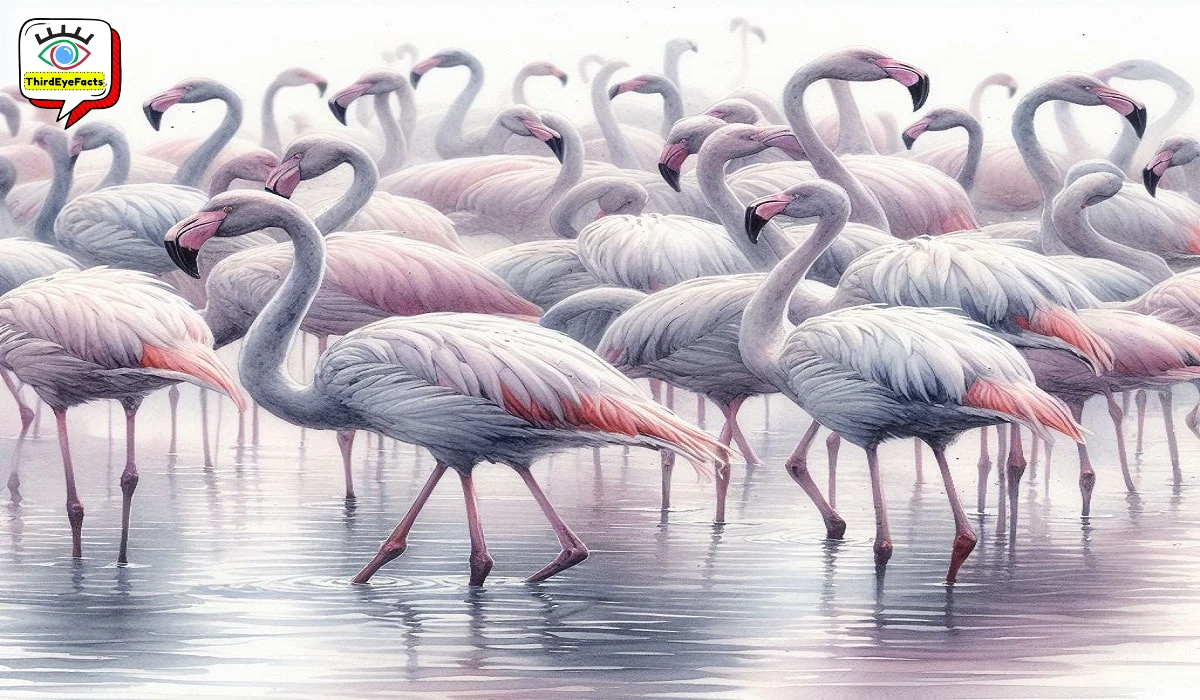Flamingos are well-known for their bright pink feathers, which look like they’ve been borrowed from a sunset. They proudly show off their pink feathers, making wetlands and lakes look beautiful. However their is an interesting secret behind why flamingos lose their pink color!
Flamingos are good at making nests. They build nests that look like piles of mud near water. The female lays one egg in a shallow hole at the top of the nest. Both parents take turns keeping the egg warm until it hatches, which takes about 30 days. When flamingo chicks are born, they’re fluffy and white. As they grow up, their bills start to curve downwards.
Flamingos inhabit many different places around the world, ranging from the Americas to Africa, Europe, and the Middle East. While most kinds of flamingos are doing well, some are having a tough time. For example, the Andean flamingo is in danger, and the Chilean, Lesser, and Puna flamingos are close to being in danger too.
1) How do flamingos get their pink color?
Flamingos are pretty in pink thanks to their diet! They munch on yummy treats like shrimp and algae, which are full of special pigments called Carotenoids.
Carotenoids are a group of pigments found in plants, algae, and certain bacteria. They are responsible for the vibrant red, orange, and yellow colors in fruits, vegetables, and flowers. These pigments play essential roles in photosynthesis, protecting plants from excessive sunlight, and attracting pollinators.
Carotenoids are organic compounds made up of carbon and hydrogen, with some containing oxygen atoms as well. They are classified into two main types: Carotenes and Xanthophylls. Carotenes are hydrocarbons, meaning they contain only carbon and hydrogen atoms, while Xanthophylls contain oxygen in addition to carbon and hydrogen.
You might have heard of beta-carotene – it’s what makes carrots orange! Other carotenoids, like lycopene in tomatoes and lutein in spinach, give those foods their colors too. Eating foods with lots of carotenoids, like fruits and veggies, can help keep us healthy and lower the risk of diseases like heart disease and cancer.
These carotenoids are like magic paint that turns them pink. When flamingos eat these shrimp and algae, these pigments go into their bodies and color their feathers, skin, and even their beaks. The more carotenoids they eat, the brighter their pink becomes! So, without these special pigments in their meals, flamingos wouldn’t be the lovely pink birds we know and adore.
2) What color are flamingos when they are born?

When baby flamingos hatch from their eggs, they’re not pink like the grown-ups. They’re more like gray or white, which helps them hide from predators. They’re born in nests made of mud, either on big mounds or volcanic islands, depending on the type of flamingo.
It takes a while for them to turn fully pink, and it can depend on things like how much food they find and how healthy they are. But eventually, they become those famous pink birds we all know!
As they grow up, flamingos keep eating foods with lots of carotenoids to stay pink. The more they eat, the pinker they become! But not all flamingos are the same shade of pink – it can vary depending on the bird and where they live.
3) Do flamingos lose their pink while caring for babies?
When female flamingos are pregnant, they don’t lose their pink color. This color comes from the food they eat, like shrimp and algae, which have special pigments that make them pink. These pigments go into the flamingos’ bodies and color their feathers, skin, and beaks.
During pregnancy, female flamingos take care of their eggs in the nest while the male helps build it and protects the area. This takes a few weeks. Even though the mom flamingos might have some changes inside their bodies to help their babies grow, it doesn’t change their pink color on the outside.
So, in short, flamingos stay pink during pregnancy because their color comes from what they eat, not from being pregnant.
4) Do flamingos lose their pink caring for babies?
Flamingos might not always stay pink because their diet affects the color of their feathers and skin. Their color can change, especially when they have babies. If a flamingo doesn’t eat its usual food or if it sacrifices its food for its babies, its pink color might fade away. This happens because parenting takes a lot of energy and resources from them.
Flamingo moms and dads make a special food called “Crop milk” to feed their babies. It’s full of good stuff like protein and fat, which helps the chicks grow strong.
What is crop milk?
Crop milk is a special kind of milk made by some birds to feed their babies. Flamingos and male emperor penguins are two kinds of birds that make this milk. In flamingos, the milk is reddish and watery in the beginning. Even though it looks like blood, it’s not. This special milk with colorful pigments gets passed from the flamingo parents to their chicks.
A hormone called prolactin helps in making this milk, just like in humans. But here’s a twist: both mom and dad birds have this hormone, so both can make milk. This special milk helps the baby birds turn pink and grow until they can eat by themselves.
Making crop milk takes a lot of energy and nutrients from the flamingo parents. So, while they’re busy feeding their babies, they might use up the pigments that make their feathers pink.
This means parent flamingos temporarily lose their pink when raising young during this time. But don’t worry, it’s normal and doesn’t mean they’re sick. It’s just because they’re putting all their energy into taking care of their babies.
Once the baby birds can find food on their own and grow up, the parent flamingos regain their usual pink color. This happens because they can eat their carotenoid rich food again, which helps them get their colorful feathers back.
5) Why do flamingos lose their pink color?

There are 4 prime reasons for flamingos too lose their pink color-
a) Molting
Flamingos periodically shed or molt their old feathers in order to grow new ones. They usually lose their flight feathers bit by bit over time, but they keep enough to still fly while getting new feathers. Their flight feathers are super important for flying. Without them, flamingos can’t soar through the air; they’re stuck on the ground or in the water.
However, sometimes, especially in captivity, they might lose all their flight feathers at once. During molting process, the pigments may not always be retained, resulting in a temporary loss of color until the fresh feathers grow in. When this happens, it takes a few weeks for them to grow back before they can fly again.
b) Health Issues
If flamingos get sick or hurt, it can mess up how their bodies work. For example, if they have problems with their stomach or liver, they might not be able to get the colorful stuff they need from their food.
When flamingos get sick, their immune system tries to fight off the germs. But this can use up a lot of energy that they could otherwise use to make their feathers colorful. As flamingos get older, their bodies don’t work as well. This means they might not be able to use the colorful stuff in their food as effectively, so their feathers might not be as colorful as they used to be.
c) Environmental Changes
When flamingos feel stressed because of changes in their environment, problems in their habitat, threats from predators, or fights with other flamingos, their bodies focus on staying alive. This means they might not use resources for things like making their feathers colorful.
d) Parenthood
When flamingo moms and dads become parents, they lose their pink color! While taking care of their babies and feeding them, they give them special milk-like stuff called “crop milk.” This stuff has a lot of colorful pigments in it. So, as the parents share this milk with their chicks, their own colors fade to a boring gray. But don’t worry! As the chicks grow up, the parents get their bright pink color back.
6) Can flamingos have colors other than pink?

Flamingos come in different shades and colors. Some are darker or brighter pink, while others might appear more orange or red. There are even flamingos that are pure white. So, you can find quite a variety among these elegant birds!
Flamingos get their color from carotenoids which are found in the foods they eat like shrimp, algae, and crustaceans. Carotenoids can produce a range of colors, including pink, orange, and red. It all depends on the specific type and concentration of carotenoids consumed.
When flamingos eat a lot of certain kinds of food, like shrimp and algae, they can turn orange or red instead of the usual pink. For example, Chilean flamingos eat a lot of foods with a pigment called Astaxanthin, which makes them look orange or red.
Other things, like genes and the environment, can also affect how colorful flamingos are. But the main thing is that what they eat decides the color of their feathers, skin, and beaks.
So, while pink is the most common color associated with flamingos, variations in diet and other factors can lead to flamingos displaying colors ranging from pink to orange or even red.
7) Are pink flamingos dangerous?
Pink flamingos are not usually dangerous to people. They’re famous for being graceful and calm. They prefer to avoid getting into fights with humans or other animals.
These birds mostly eat plants and tiny sea creatures, using their special beaks to scoop up their food from the water. They don’t hunt or attack people, so they’re not a threat.
However, like any wild animal, flamingos might try to protect themselves if they feel scared or trapped. In rare cases, they might use their beaks or wings to defend themselves. But this only happens if they’re really afraid.
Overall, flamingos are gentle creatures that are fun to watch. As long as we keep a safe distance and don’t bother them, they’re perfectly safe to be around.
Read more: 10 Stunning migratory birds in India you must see.

